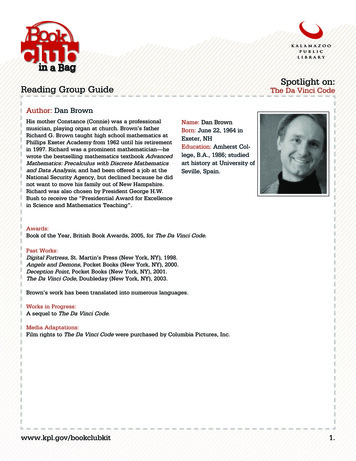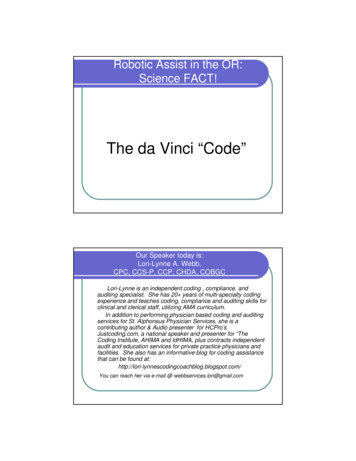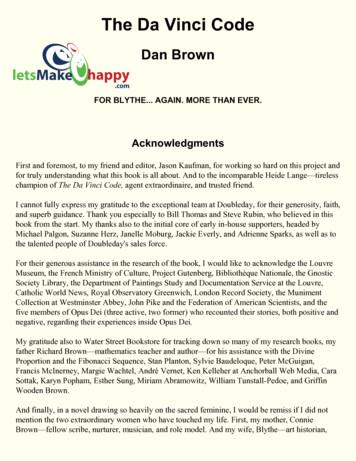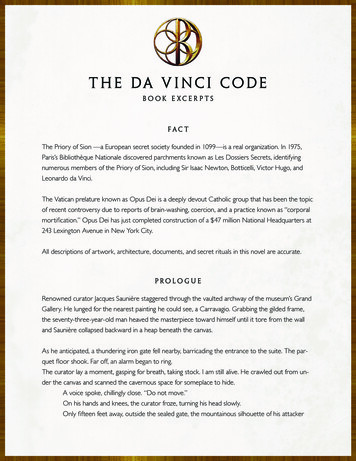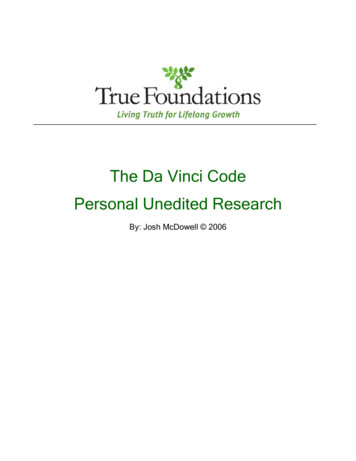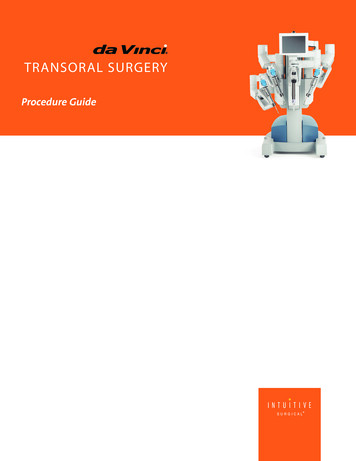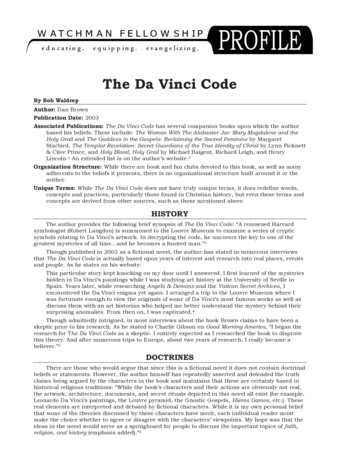
Transcription
The Da Vinci CodeBy Bob WaldrepAuthor: Dan BrownPublication Date: 2003Associated Publications: The Da Vinci Code has several companion books upon which the authorbased his beliefs. These include: The Woman With The Alabaster Jar: Mary Magdalene and theHoly Grail and The Goddess in the Gospels: Reclaiming the Sacred Feminine by MargaretStarbird, The Templar Revelation: Secret Guardians of the True Identity of Christ by Lynn Picknett& Clive Prince, and Holy Blood, Holy Grail by Michael Baigent, Richard Leigh, and HenryLincoln.1 An extended list is on the author’s website.2Organization Structure: While there are book and fan clubs devoted to this book, as well as manyadherents to the beliefs it presents, there is no organizational structure built around it or theauthor.Unique Terms: While The Da Vinci Code does not have truly unique terms, it does redefine words,concepts and practices, particularly those found in Christian history, but even these terms andconcepts are derived from other sources, such as those mentioned above.HISTORYThe author provides the following brief synopsis of The Da Vinci Code: “A renowned Harvardsymbologist (Robert Langdon) is summoned to the Louvre Museum to examine a series of crypticsymbols relating to Da Vinci’s artwork. In decrypting the code, he uncovers the key to one of thegreatest mysteries of all time and he becomes a hunted man.”3Though published in 2003 as a fictional novel, the author has stated in numerous interviewsthat The Da Vinci Code is actually based upon years of interest and research into real places, eventsand people. As he states on his website:This particular story kept knocking on my door until I answered. I first learned of the mysterieshidden in Da Vinci’s paintings while I was studying art history at the University of Seville inSpain. Years later, while researching Angels & Demons and the Vatican Secret Archives, Iencountered the Da Vinci enigma yet again. I arranged a trip to the Louvre Museum where Iwas fortunate enough to view the originals of some of Da Vinci’s most famous works as well asdiscuss them with an art historian who helped me better understand the mystery behind theirsurprising anomalies. From then on, I was captivated.4Though admittedly intrigued, in most interviews about the book Brown claims to have been askeptic prior to his research. As he stated to Charlie Gibson on Good Morning America, “I began theresearch for The Da Vinci Code as a skeptic. I entirely expected as I researched the book to disprovethis theory. And after numerous trips to Europe, about two years of research, I really became abeliever.”5DOCTRINESThere are those who would argue that since this is a fictional novel it does not contain doctrinalbeliefs or statements. However, the author himself has repeatedly asserted and defended the truthclaims being argued by the characters in the book and maintains that these are certainly based inhistorical religious traditions: “While the book’s characters and their actions are obviously not real,the artwork, architecture, documents, and secret rituals depicted in this novel all exist (for example,Leonardo Da Vinci’s paintings, the Louvre pyramid, the Gnostic Gospels, Hieros Gamos, etc.). Thesereal elements are interpreted and debated by fictional characters. While it is my own personal beliefthat some of the theories discussed by these characters have merit, each individual reader mustmake the choice whether to agree or disagree with the characters’ viewpoints. My hope was that theideas in the novel would serve as a springboard for people to discuss the important topics of faith,religion, and history (emphasis added).”6
THE BEST RESOURCE COLLECTION ON CULTS AND RELIGIONSThe Watchman Fellowship ProfileNotebook provides you with an extensive personal library of information about cults, new and alternative religions, world religions, andreligious leaders. You will have atyour fingertips over twenty years ofresearch to answer your questions,strengthen your faith, and improveyour witness to others. Over 100 ProfilesOver 400 pages of informationThe history and primary teachings ofeach groupA Christian responseto deepen your faithand enhance your outreachClick here to order your copy of the watchman fellowship profile notebookBe sure to also order your free subscription to the Watchman Fellowship Profile. Several timeseach year you will receive a new, four-page Profile that you can add to your Profile Notebook, aswell as the latest news from Watchman Fellowship. Click here to order your free subscription!
The Da Vinci Code, page 2Charlie Gibson asked Brown, “if you were writing it [The Da Vinci Code] as a nonfiction book,how would it have been different?” Brown replied, “I don’t think it would have it is important toremember this is a novel about a theory that has been out there for a long time.” When Gibsonpointed out that a number of Catholic religious leaders had said this was based on a “crackpottheory,” Brown replied, “Yeah, again, it’s a theory that’s been out there for quiet a while. When I firstheard it, I said this is a crackpot theory. I began researching it, after two years I decided this theorymakes more sense to me than what I was taught as a child.”7Perhaps Brown is expressing this personally held view through the words of his character SirLeigh Teabing when Teabing states, “almost everything our fathers taught us about Christ is false.”8His website has a group discussion guide that provides further clues that Brown’s intends for thereader to interact with the book on more than just a fictional level. For example, the reader is askedto consider:Now that you have read the Da Vinci Code, are there any aspects of life/history/faith that yousee in a different light? (Question 2)Historian Leigh Teabing claims that the founding fathers of Christianity hijacked the good nameof Jesus for political reasons. Do you agree? Does the historical evidence support Teabing’sclaim? (Question 8)Has this book changed your ideas about faith, religion, or history in any way? (Question 9)Would you rather live in a world without religion or a world without science? (Question 14)For most people, the word “God” feels holy, while the word “Goddess” feels mythical. What areyour thoughts on this? Do you imagine those perceptions will ever change? (Question 17)9Following are the doctrines presented through the book’s characters:God: Deity is defined as the sacred feminine, the goddess. Brown believes that through theyears Christianity has perverted this correct view of God, making God into a masculine patriarchalfigure rather than the feminine matriarchal original.Legend tells us the Holy Grail is a chalice—a cup. But the Grail’s description as a chalice isactually an allegory to protect the true nature of the Holy Grail The Grail is literally theancient symbol for womanhood and the Holy Grail represents the sacred feminine and thegoddess, which of course has now been lost, virtually eliminated by the Church.10When Christianity came along, the old pagan religions did not die easily. Legends of chivalricquests for the lost grail were in fact stories of forbidden quests to find the lost sacredfeminine [using] code as a way to protect themselves from a Church that had subjugatedwomen, banished the Goddess, burned nonbelievers, and forbidden the pagan reverence for thesacred feminine.11Jesus: Jesus was not God, nor did he claim to be so. He was a mortal prophet who lived as aman, marrying Mary Magdalene and fathering a daughter by her.At this gathering [Council of Nicea in 325 AD] many aspects of Christianity were debated andvoted upon until that moment in history, Jesus was viewed by his followers as a mortalprophet Jesus establishment as the ‘Son of God’ was officially proposed and voted on by theCouncil of Nicea A relatively close vote at that.12Behold, the greatest cover-up in human history. Not only was Jesus Christ married, but He wasa father. My dear, Mary Magdalene was the Holy Vessel. She was the chalice that bore the royalbloodline of Jesus Christ. She was the womb that bore the lineage, and the vine from which thesacred fruit sprang forth.13Mary Magdalene was pregnant at the time of the crucifixion With the help of Jesus’ trusteduncle, Joseph of Arimathea [she] secretly traveled to France, then known as Gaul. There shefound safe refuge in the Jewish community. It was here in France that she gave birth to adaughter. Her name was Sarah.14The Bible: The Bible is not the Word of God but a fabrication of men written, at the direction ofConstantine, to support their own views and provide a basis for their own authority. The correctteachings concerning Jesus and the early Church can be found in the Gnostic Gospels.More than eighty gospels were considered for the New Testament, and yet only a relative fewwere chosen for inclusion The Bible as we know it today was collated by the pagan RomanEmperor Constantine the Great.15From this sprang the most profound moment in Christian history. Constantine commissionedand financed a new Bible, which omitted those gospels that spoke of Christ’s human traits andembellished those gospels that made him godlike. The other gospels were outlawed, gatheredup, and burned.16
The Da Vinci Code, page 3The modern Bible was compiled and edited by men who possessed a political agenda—topromote the divinity of the man Jesus Christ and use His influence to solidify their own powerbase.17These [Gnostic Gospels] are the earliest Christian records. Troublingly, they do not match upwith the gospels in the Bible.18Church: Jesus came to establish the Church under the leadership of his wife, Mary Magdalene,and through her to restore the right worship of the sacred feminine. His lineage through theirdaughter (the Merovingian dynasty of France) continued this proper worship of the Church, and it isstill carried out today through a secret society, the Priory of Sion.At this point in the gospels, Jesus suspects He will soon be captured and crucified. So he givesMary Magdalene instructions on how to carry on His Church after He is gone Jesus was theoriginal feminist. He intended for the future of His Church to be in the hands of MaryMagdalene.19Mary Magdalene was pregnant at the time of the crucifixion With the help of Jesus’ trusteduncle, Joseph of Arimathea [she] secretly traveled to France, then known as Gaul. There shefound safe refuge in the Jewish community. It was here in France that she gave birth to adaughter. Her name was Sarah.20The quest for the Holy Grail is literally the quest to kneel before the bones of Mary Magdalene.A journey to pray at the feet of the outcast one, the sacred feminine.21The Priory of Sion, to this day, still worships Mary Magdalene as the Goddess, the Holy Grail,the Rose and the Divine Mother.22Sacred Sex/Worship: Through his characters, Brown establishes that divinity can only beproperly realized through sacred sex.The ancients believed that the male was spiritually incomplete until he had carnal knowledge ofthe sacred feminine. Physical Union with the female remained the sole means through whichman could become spiritually complete and achieve gnosis—knowledge of the divine.23Intercourse was the revered union of the two halves of the human spirit – male and female—through which the male could find spiritual wholeness and communion with God.24The early Jewish tradition involved ritualistic sex. In the Temple, no less. Early Jews believedthat the Holy of Holies in Solomon’s Temple housed not only God but also His powerful femaleequal, Shekinah. Men seeking spiritual wholeness came to the Temple to visit priestesses withwhom they made love and experienced the divine through physical union.25[Professor Langdon speaking to a class at Harvard] See if you cannot approach sex as amystical, spiritual act. Challenge yourself to find that spark of divinity that man can onlyachieve through union with the sacred feminine.26Conspiracy Theories: Setting aside or rewriting the historical record is essential to thebelievability of the theories set forth in The Da Vinci Code. In interviews, the author has repeatedlines from one of the book’s characters as to why the historical record should not be trusted:History is always written by the winners. When two cultures clash, the loser is obliterated andthe winner writes the history books—books which glorify their cause and disparage theconquered foe By its very nature, history is always a one-sided account.27[The Church] buried evidence of Christ’s marriage to her, thereby defusing any potential claimsthat Christ had a surviving bloodline and was a mortal prophet.28The Sangreal documents [Secret writings supposedly confirming the theories set forth in The DaVinci Code and allegedly filling four enormous trunks that are protected by the KnightsTemplar] simply tell the other side of the Christ story which side of the story you believebecomes a matter of faith and personal exploration, but at least the information has survived.29The modern Priory of Scion has a momentous duty. Theirs is a threefold charge protect theSangreal documents protect the tomb of Mary nurture and protect the bloodline of Christ –those few members of the royal Merovigian bloodline who have survived into modern times.30The Church and the Priory have had a tacit understanding for years the Church does notattack the Priory and the Priory keeps the Sangreal documents hidden However, part of thePriory history has always included a plan to unveil the secret unveiling [on a specific date] theSangreal documents to the world and shouting the true story of Jesus Christ from themountaintops.31
The Da Vinci Code, page 4CHRISTIAN/BIBLICAL RESPONSEDespite the author’s view, the historical record does not support his contentions. Even were hecorrect that the winners write history, Christian scholar Douglas Groothuis has accurately noted,Many sympathetic with Gnosticism make much of the notion that the Gnostic writings weresuppressed by the early Christian church. But this assertion does not, in itself, provide supportone way or the other for the truth or falsity of Gnostic doctrine. If truth is not a matter ofmajority vote, neither is it a matter of minority dissent.32Constantine did not commission the Bible, nor did he initiate a vote to proclaim Jesus is God.The Council of Nicea in 325 A.D. affirmed what the Church had taught from its inception—the deityof Jesus. And it was not a close vote as Brown states, rather there were two dissenting votes.The doctrine of the Trinity, which teaches that the Father is God, the Son is God and the HolySpirit is God—One God, was not determined by the vote of a Council; it is established in Scripture:Isa. 43:10; 44:6-8; 45:5-6, 18, 22; 1 Cor. 8:4. Father is God: 2 Peter 1:17; Phil. 2:11. Son is God:John 1:1; John 8:58; Rom. 9:5; Phil. 2:6-9; Heb. 1:8. Holy Spirit is God: Acts 5:3-4. Concerning theclaim Jews practiced ritualistic sex at the Temple, Scripture is clear: “No Israelite man or woman isto become a shrine prostitute,” Deut 23:17, see also v. 18. Lev 19:29; Lev 21:9RECOMMENDED READINGCracking Da Vinci’s Code by James L. Garlow and Peter Jones. Throughout The Da Vinci Code,author Dan Brown skillfully weaves “historical” assertions intended to shake the very foundations ofChristianity. Garlow and Jones present compelling evidence that Brown’s assertions are not onlyhistorically inaccurate, but may also contain a hidden agenda. 252 pages, includes reader’s guide.The Truth Behind The Da Vinci Code by Richard Abanes. Nationally recognized researcherRichard Abanes, explores the answers to many of the questions that The Da Vinci Code, raises: WereJesus and Mary Magdalene married? Has the church suppressed the truth about the “LostGospels”? What is the real nature of the Holy Grail? This book goes behind the scenes to separatefact from fiction. 96 pages.Breaking The Da Vinci Code: Answers to the Questions Everybody’s Asking by Darrell L. BockThe author responds to the novelist’s claims using central ancient texts, uncovering the origins ofthese codes by focusing on the 325 years immediately following the birth of Christ. This bookdistinguishes fictitious entertainment from historical elements of the Christian faith. 208 pages.Church History in Plain Language by Dr. Bruce Shelley. Excellent resource, for both lay peopleand church leaders, that makes history easy to follow and easy to retain. It reads like a novel andmakes church history clear, memorable, and accessible to every reader. 520 pages.NotesDan Brown, The Da Vinci Code, (New York: Doubleday, 2003), 253.2 Dan Brown, “Partial Bibliography for the Da Vinci Code,” www.danbrown.com/novels/davinci code/bibliography.html (accessed December 2004).3 Dan Brown, “Common Questions,” www.danbrown.com/novels/davinci code/faqs.html (accessed December 2004).4 www.danbrown.com/novels/davinci code/faqs.html.5 Good Morning America, 11/3/03.6 www.danbrown.com/novels/davinci code/faqs.html.7 Good Morning America, 11/3/03.8 The Da Vinci Code, 235.9 Dan Brown, “Book Group Questions,” www.danbrown.com/novels/davinci code/book group.html (accessed December 2004).10 The Da Vinci Code, 238.11 Ibid., 238-239.12 Ibid., 233.13 Ibid., 249.14 Ibid., 255.15 Ibid., 231.11617181920212223242526272829303132Ibid., 234.Ibid., 234.Ibid., 245-346.Ibid., 247-248.Ibid., 255.Ibid., 257.Ibid., 255.Ibid., 308.Ibid., 309.Ibid., 309.Ibid., 310.Ibid., 256.Ibid., 254.Ibid., 256.Ibid., 258.Ibid., 267.Douglas Groothuis “The Gnostic Gospels: Are They Authentic?”Christian Research Journal, Winter 1991, 19.Profile is a regular publication of Watchman Fellowship, Inc. Readers are encouraged to begin their ownreligious research notebooks using these articles. Profiles are published by Watchman Fellowshipapproximately 6 times per year, covering subjects such as new religious movements, counterfeitChristianity, the occult, New Age Spirituality, and related doctrines and practices. Complete ProfileNotebooks containing all Profiles published to date are available. Please contact Watchman Fellowshipfor current pricing and availability. All rights reserved 2004.
The Da Vinci Code By Bob Waldrep Author: Dan Brown Publication Date: 2003 Associated Publications: The Da Vinci Code has several companion books upon which the author based his beliefs. These include: The Woman With The Alabaster Jar: Mary Magdalene and the Holy Grail and The Goddess in the Gospels: Reclaiming the Sacred Feminine by Margaret .


